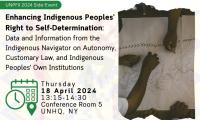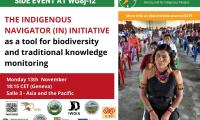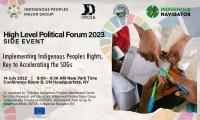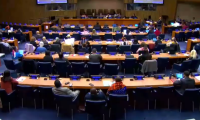Submission to the Secretariat of the Convention on Biological Diversity on behalf of the Indigenous Navigator
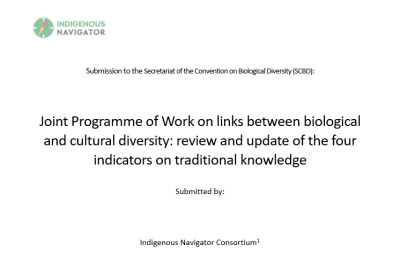
Joint Programme of Work on links between biological and cultural diversity: review and update of the four indicators on traditional knowledge
Joint Programme of Work on links between biological and cultural diversity: review and update of the four indicators on traditional knowledge
Submitted by:
Indigenous Navigator Consortium[1]
This written statement is submitted on behalf of the Indigenous Navigator consortium to the Secretariat of the Convention on Biological Diversity (SCBD) in response to the call for submissions on the: “Joint Programme of Work on links between biological and cultural diversity: review and update the four indicators on traditional knowledge.”
It is regarding the four traditional knowledge indicators already adopted by the CBD on the status and trends on:
- Linguistic diversity and number of speakers of indigenous languages
- Land use change and land tenure in the traditional territories of Indigenous Peoples and Local Communities (IPs and LCs)
- Practice of traditional occupations
- Degree to which traditional knowledge and practices are respected through the full integration, participation, and safeguards in national implementation of the Strategic Plan.
The Indigenous Navigator consortium welcomes the review of information on the status of the data and information, operationalization, review, and update of the four traditional knowledge indicators, following the last information note produced by the Working Group on Article 8(j) and Related Provisions.
The Indigenous Navigator is a primary example of community-based monitoring and information systems, which target the implementation and realisation of Indigenous Peoples’ rights at national and community level. Since it was developed and piloted in 2014, the Indigenous Navigator’s tools and methodologies have included indicators on the CBD. Since the development of the information note, there have been vital developments in data generation, tools and methodologies on the indicators which are relevant for Indigenous Peoples, and which can contribute to the effective monitoring of the Kunming Montreal Global Biodiversity Framework (KMGBF) and its indicator framework.
The Indigenous Navigator: Data by and for Indigenous Peoples
The Indigenous Navigator is an Indigenous Peoples-led community-based monitoring tool toward the implementation of the UNDRIP (United Nations Declaration on the Rights of Indigenous Peoples), the Convention on Biological Diversity (CBD) as it relates to Indigenous Peoples, core human rights obligations, essential aspects of the Sustainable Development Goals, as well as the outcomes of the World Conference on Indigenous Peoples. It is a comprehensive tool that enables systematic monitoring of all major provisions of the UNDRIP. The Indigenous Navigator was launched not only, to collect data by and for Indigenous Peoples, but also to be able to assess whether, and how, the UNDRIP, and human rights obligations, are being implemented and what real changes, if any, are being made at national and community level. As of 2023, the Indigenous Navigator is being used in twenty-eight countries[2], current published community level data covers approximately 300,000 Indigenous persons and over 300 Indigenous communities. The tool is available online[3], and accessible to Indigenous organizations and human rights actors wishing to systematically monitor the implementation of the provisions under the UNDRIP.
The Indigenous Navigator generates data at the national and community levels through three types of human rights indicators: structural, process and outcome indicators. Structural indicators reflect the legal and policy framework of a given country. Process indicators measure the States’ ongoing efforts to implement human rights commitments through programs, budget allocations and other strategies. Outcome indicators capture the actual enjoyment of human rights by Indigenous Peoples in their everyday lives.
These multiple levels of data generation and management allow for producing critical documentation that drives forward advocacy and for developing monitoring frameworks to better understand and recognise the implementation gaps in relation to Indigenous Peoples’ rights, in line with international human rights law and obligations. Further, as the community survey data is collected directly by Indigenous communities themselves, the data also guides problem identification and project design for Indigenous communities and organisations. The Indigenous Navigator supports the role of data at the local level in empowering Indigenous communities to claim the full realisation and implementation of their rights, through for example, environmental monitoring by communities or determining their own locally and culturally appropriate well-being indicators.
Methodology:
The Indigenous Navigator is organised in two surveys, national and community, covering thirteen thematic domains that address issues relevant for Indigenous Peoples.
It is critical to emphasise that those indicators and surveys were developed by Indigenous Peoples, grounded in the methodology suggested by the Office of the High Commissioner for Human Rights (OHCHR) for human rights indicators[4]. To do so, the Indigenous Navigator consortium, adapted this methodology to the rights of Indigenous Peoples in the following sequence:
- Structuring the rights contained in the UN Declaration on the Rights of Indigenous Peoples (UNDRIP) into thirteen thematic domains[5];
- Further dividing the domains into thirty-two sub-categories and identifying the relevant articles of the UNDRIP and related human rights instruments;
- Defining sixty-six key attributes of the rights enshrined in the UNDRIP; and
- Choosing the right indicators to measure the status of their attainment[6].
This process and practice should serve as a leading example of a best practice in the monitoring of the implementation of the rights of Indigenous Peoples, and particularly the UNDRIP. [7] This is relevant especially in the light of specific recommendation issued by the UNPFII (United Nations Permanent Forum on Indigenous Issues) during its 16th session in 2017 that “encourage[d] collaboration and contributions from Governments, the agencies of the United Nations system, Indigenous Peoples and civil society organizations to the Indigenous Navigator framework and other tools in order to strengthen community-based monitoring of global commitments made under the Declaration, the World Conference and the Sustainable Development Goals.”[8]
The Indigenous Navigator and indicators tied to the CBD:
As noted above, the Indigenous Navigator is a robust and well-developed community-based tool for monitoring Indigenous Peoples rights. KMGBF’s recognition of Indigenous Peoples’ rights to lands, territories and resources, traditional knowledge, Free Prior Informed Consent (FPIC) and participation in decision-making is a key advancement in the recognition of Indigenous Peoples’ contributions.
In the existing framework and tool, the CBD is directly linked to fifteen indicators, developed into eighteen questions (six at national level and twelve at community level) across two domains[9].
Linked to CBD Article 8(j):
- Development, in conjunction with the indigenous peoples concerned, of fair, transparent and effective mechanisms for access to and repatriation of ceremonial objects and human remains at the national level (I25) Process Indicator, National Survey; Art. 11.1 UNDRIP; WCIP Commitment: 27
- Incidents of misappropriation of cultural heritage, traditional knowledge, and traditional cultural expressions (I83) Outcome indicator; National and Community Survey; Art. 31.1 UNDRIP
- Restrictions to indigenous peoples’ free and privileged access to religious and cultural sites (I64) Outcome indicator; Community Survey; Art. 31.1 UNDRIP
- Prevalence of persons devoting time to selected cultural, spiritual, and religious traditions, customs, and ceremonies (I156) Outcome indicator; Community survey. Art. 11.1 UNDRIP
Linked to CBD Article 10:
- Possibility to perform traditional occupations (such as pastoralism, hunting/gathering, shifting cultivation, fishing) without restrictions. (I2) Outcome indicator; Community survey. Art. 26.2 UNDRIP; WCIP Commitment: 25
- Issues concerning land and resource use are handled by indigenous peoples’ autonomous institutions (I3) Outcome indicator; Community survey. Art. 26.2 UNDRIP; WCIP Commitment: 19
- Incidents of conflicting land or resource claims (I1) Outcome indicator; Community survey. Art. 26.2 UNDRIP; WCIP Commitment: 19
- Incidents of settlements, land grabbing, land use or resource extraction without indigenous peoples’ free, prior, and informed consent. (I93) Outcome indicator; Community and National survey. Art. 26.2 UNDRIP; WCIP Commitment: 19
- Sanctioning of violators of indigenous peoples’ rights to lands and territories (I5) Outcome indicator; Community Survey. Art. 26.2 UNDRIP; WCIP Commitment: 24
- Proportion of [indigenous] people with ownership or secure rights over land (out of total community population), disaggregated by sex. In order to capture relevant information related to this broad indicator; the following sub-indicators are guiding the questions: Characteristics of indigenous peoples' traditional land tenure systems; Extension of indigenous peoples' traditional territories (CA): Extension of lands covered by collective title deeds or other binding agreements; Percentage of men and women with title deeds or other binding agreements in recognition of their individual rights to lands. (I86) Outcome indicator; Community Survey. Art 25, 26.1, 26.3, UNDRIP; SDG Indicator: 5.a.1.a
- Recognition of indigenous peoples’ rights to lands, territories, and resources in national legislation. (I116) Structural indicator; Community and National Survey. Art 25, 26.1, 26.3, UNDRIP; WCIP Commitment: 24
- Clear procedures adopted by the State for identification, demarcation, mapping and registration of indigenous peoples’ lands or territories lands in consultation with and in accordance with indigenous norms, values, and customs. (I13) Process indicator; National Survey. Art 26.2, 27, UNDRIP
However, there are several additional areas where the rights enshrined in the UNDRIP, WCIP and the SDGs, and incorporated into the Indigenous Navigator’s framework, can inform. For example, in relation to:
Linguistic diversity and number of speakers of Indigenous languages: Under the domains of Cultural Integrity, Freedom of Expression and Education.
- Degree of endangerment of indigenous peoples’ languages (I23). Outcome Indicator. UNDRIP Art. 13.1
- Recognition of indigenous languages among the official languages of the country (I112) Structural indicator; UNDRIP Art. 13.1; WCIP PARA. 14
- Use of indigenous languages in systems of signposting, documentation, and official communications (I150) Outcome indicator; UNDRIP Art. 13.1
- State special measures for indigenous youth in the area of transmission of traditional knowledge, languages, and practices (I68). Process Indicator; WCIP PARA. 15
- Recognition in national legislation of indigenous peoples’ right to establish their own media (I58). Structural indicator; UNDRIP Art. 16.1
- Broadcasting or use of indigenous languages in State-owned media, such as a) radio, b) TV, c) internet sites (I11) Outcome indicator; UNDRIP Art. 16.2
- Percentage of [indigenous] children/young people: (a) in Grade 2/3; (b) at the end of primary; and (c) at the end of lower secondary achieving at least a minimum proficiency level in (i) reading and (ii) mathematics, by sex (I133). Outcome indicator; SDG INDICATOR: 4.1.1; WCIP PARA. 11
- Extent to which primary education is conducted in indigenous languages (I55) Outcome indicator; UNDRIP Art. 14, 15.1. WCIP PARA. 11
- Extent to which secondary education is conducted in indigenous languages (I57) Outcome indicator; UNDRIP Art. 14, 15.1. WCIP PARA. 11
Practice of traditional occupations - as noted above in regard to Article 10, but in addition under the domain of Employment and Occupation
- Status and trends in traditional occupations. (I138) Outcome indicator; UNDRIP Art. 20.1
- Which are the most important traditional occupations performed by women in your people/community (list up to five)? Q118(LCS)
- How has the importance of these traditional occupations for women changed over the last 20 years? Q119(LCS)
- What are the main barriers or restrictions for performing these traditional occupations today? Q120(LCS)
- Which are the most important traditional occupations performed by men in your people/community (list up to five)? Q121(LCS)
- How has the importance of these traditional occupations for men changed over the last 20 years? Q122(LCS)
- What are the main barriers or restrictions for performing these traditional occupations today? Q123(LCS)
- Possibility to perform traditional occupations (such as pastoralism, hunting/gathering, shifting cultivation, fishing) without restrictions (I2) Outcome indicator; UNDRIP Art. 20.1; WCIP PARA. 25
- Can your people/community perform their traditional occupations (such as pastoralism, hunting/gathering, shifting cultivation, fishing) without restrictions? Q124(LCS)
- State special measures to provide vocational training according to indigenous peoples’ special needs or traditional occupations (I134) Process indicator; UNDRIP Art. 20.1; WCIP PARA. 25
- Has the State developed special measures to provide vocational training according to indigenous peoples’ special needs or traditional occupations? Q112(LNS)
Regarding the degree to which traditional knowledge and practices are respected through the full integration, participation, and safeguards in national implementation of the Strategic Plans – here the additional crossovers are linked to indicators present within the primary domains of Self-determination, Fundamental rights and freedoms, and Participation in public life.
- Existence of indigenous peoples' self-governing institutions (I51) Outcome indicator; UNDRIP Art 5, 18, 20.1, 33.2, 34, 39; ILO C169 Art 4.1, 6.1(c), 8.2
- Recognition of indigenous peoples’ self-governing institutions and territories in the political-administrative structure of the State (I12) Structural indicator; UNDRIP Art 5, 18, 20.1, 33.2, 34, 39; ILO C169 Art 4.1, 6.1(c), 8.2
- Issues concerning planning of local development projects are handled by indigenous peoples’ autonomous institutions (I105) Outcome indicator; UNDRIP Art 5, 18, 20.1, 33.2, 34, 39; ILO C169 Art 4.1, 6.1(c), 8.2; WCIP PARA. 11
- Allocation of public funds (from central/local government) to indigenous peoples’ self-government institutions (I14) Process indicator; UNDRIP Art 5, 18, 20.1, 33.2, 34, 39; ILO C169 Art 4.1, 6.1(c), 8.2
- Issues concerning land and resource use are handled by indigenous peoples’ autonomous institutions (I3) Outcome indicator; UNDRIP Art 5, 18, 20.1, 33.2, 34, 39; ILO C169 Art 4.1, 6.1(c), 8.2; WCIP PARA. 19
- State special measures to strengthen capacity of indigenous peoples’ representative institutions (I70) Process indicator; UNDRIP Art 5, 18, 20.1, 33.2, 34, 39; ILO C169 Art 4.1, 6.1(c), 8.2
- Recognition of indigenous peoples’ right to self-government in national legislation (I60) Structural indicator; UNDRIP Art 5, 18, 20.1, 33.2, 34, 39; ILO C169 Art 4.1, 6.1(c), 8.2
- Consultations with indigenous peoples’ autonomous institutions before approval of measures and projects that may affect you (I19) Outcome indicator; UNDRIP Art. 19, 32.2; WCIP PARA. 3; ILO C169 Art. 6.1(a), 6.2
- Free, prior, and informed consent of indigenous peoples’ autonomous institutions before approval of measures that may affect them (I59) Outcome indicator; UNDRIP Art. 19, 32.2; WCIP PARA. 3; ILO C169 Art. 6.1(a), 6.2
- Recognition of the state duty to consult with indigenous peoples before adopting or implementing legislative or administrative measures that may affect them and prior to approval of any project that affects their lands, territories, and resources in national legislation (I120) Structural indicator; WCIP PARA. 3; UNDRIP Art. 19, 32.2; ILO C169 Art. 6.1(a), 6.2
- Procedures or mechanisms for State consultation with indigenous peoples at national, sub-national and local levels (I24) Process indicator; UNDRIP Art. 19, 32.2; ILO C169 Art. 6.1(a), 6.2; WCIP PARA. 3
- Incidents of conflicting land or resource claims (I1) Outcome indicator; UNDRIP Art. 19, 32.2; ILO C169 Art. 6.1(a), 6.2; WCIP PARA. 19
Under the domain of Fundamental freedoms:
- National action plans developed by States, in consultation and cooperation with indigenous peoples, to achieve the ends of the UNDRIP (I111) Process indicator; UNDRIP Art. 1, 38, 46.2, 46.3; ILO C169 Art. 3.1, 3.2; WCIP PARA. 8
- Special measures within national action plans to promote and protect the rights of indigenous persons with disabilities and continue to improve their social and economic conditions (I130) Process indicator; UNDRIP Art. 2; CRC Art. 2; ICCPR Art. 2.1, 24.1, 26; ICERD Art 2.1; ICESCR Art. 2.2; ILO C169 Art. 2, 3.1, 8.3; UDHR Art. 2, 21.2; WCIP PARA. 9
Under the domain of Lands, territories, and resources:
- Social, spiritual, cultural, and environmental impact assessments are undertaken prior to approval of projects that may affect indigenous peoples’ lands, territories, or resources, with the participation of indigenous peoples’ representative institutions (I126) Process indicator; UNDRIP Art. 29.1; ILOC169 Art. 7.4; WCIP PARA. 35
- Establishment and extension of State-designated protected areas on indigenous peoples' territories without free, prior, and informed consent (I49) Process indicator; UNDRIP Art. 29.1; ILOC169 Art. 7.4
Under the domain of Participation in public life:
- Recognition of the right of indigenous peoples to participate in decisions that may affect them, through their representative institutions, in national legislation (I62) Structural indicator; UNDRIP Art. 18; CEDAW Art. 7, 8; CRC Art. 12.1; ICCPR Art. 25(a-b); ICERD Art. 5(c); ILOC169 Art 6.1(b); UDHR ART 21.1.
- Provisions for direct participation of indigenous peoples’ elected representatives in legislative and appointed bodies (I18) Structural indicator; UNDRIP Art. 18; CEDAW Art. 7, 8; CRC Art. 12.1; ICCPR Art. 25(a-b); ICERD Art. 5(c); ILOC169 Art 6.1(b); UDHR ART 21.1; WCIP PARA. 3
- Proportion of seats held by [indigenous] women in(a) national parliaments and (b) local governments (I102) Outcome indicator; SDG INDICATOR: 5.5.1; UNDRIP Art. 18; CEDAW Art. 7, 8; CRC Art. 12.1; ICCPR Art. 25(a-b); ICERD Art. 5(c); ILOC169 Art 6.1(b); UDHR ART 21.1.
- Proportion of adult indigenous individuals who have the possibility to vote in elections for national and local government (I92) Outcome indicator; UNDRIP Art. 18; CEDAW Art. 7, 8; CRC Art. 12.1; ICCPR Art. 25(a-b); ICERD Art. 5(c); ILOC169 Art 6.1(b); UDHR ART 21.1.
Status of assessment:
Over 170 community level surveys and 15 national surveys have been completed and published in the Indigenous Navigator’s global portal, and another 90 community and 14 National surveys are expected to be completed by end of 2023. The community generated data is critical to effective monitoring and implementation of the CBD.
Future work:
Throughout 2023, following the adoption of the KMGBF, the Indigenous Navigator is in the process of being expanded with a survey module specifically focused on biodiversity which will increase its coverage and include new indicators to incorporate the advancements under the KMGBF.
Update to the Indicators
The Indigenous Navigator framework and tools offer a unique approach to understanding the implementation of Indigenous Peoples’ rights. The methodology and indicators serve as a leading example of best practice in the monitoring of the implementation of the rights of Indigenous Peoples, particularly the UNDRIP, and can contribute to the effective monitoring of the Kunming Montreal Global Biodiversity Framework (KMGBF) and its indicator framework.
The Indigenous Navigator consortium invites the Secretariat of the Convention on Biological Diversity to explore the Indigenous Navigator framework and tools and engage in a discussion regarding the existing methodology and indicators to inform their future work. The Indigenous Navigator project has the potential to contribute to the goals of the CBD, particularly in relation to the conservation and sustainable use of biological diversity. The consortium welcomes the opportunity to discuss this further.
[1] Prepared by International Work Group for Indigenous Affairs (IWGIA), Forest Peoples Programme, the Danish Institute for Human Rights, Asia Indigenous Peoples Pact and Tebtebba.
[2] Argentina, Bangladesh, Bolivia, Brazil, Cambodia, Cameroon, Chile, Colombia, Ecuador, Finland, Guyana, India, Myanmar, Japan, Kenya, Malaysia, Mexico, Nepal, Norway, Paraguay, Peru, Philippines, South Africa, Suriname, Sweden, Thailand, Uganda, and Tanzania
[4] OHCHR, 2012. “Human Rights Indicators, A Guide to Measurement and Implementation.” http://www.ohchr.org/Documents/Publications/Human_rights_indicators_en.pdf
[5] General enjoyment of human rights and fundamental freedoms without discrimination; Self-determination; Cultural Integrity; Lands, territories, and resources; Fundamental rights and freedoms; Participation in public life; Legal protection, access to justice and remedy; Cross-border contacts; Freedom of expression and media; General economic and social development; Education; Health; Employment and occupation
[6] The final indicators adopted by the Indigenous Navigator framework were selected from: Indicators suggested by Indigenous Peoples in previous processes; The global indicators adopted for monitoring the SDGs; Indicators already used by international agencies; and New indicators developed by the Indigenous Navigator partners, tailored specifically to assess compliance with the UNDRIP and with WCIP commitments by States.
[7] Detail on the development of the methodology and indicators can be found here:
[8] E/2017/43-E/C.19/2017/11, para. 29.
[9] The framework, indicators, questions and guidance are available for these 18 questions here: The Indigenous Navigator Tools Database (humanrights.dk) - https://navigator.humanrights.dk/the-explorer?c=All&u=All&it=All&ic=All&ka=All&i=812&s=&s_c=1&s_u=1&s_a=1&s_ri=1&s_i=1&s_g=1&s_q=1

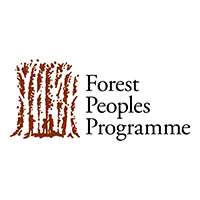
Contact

